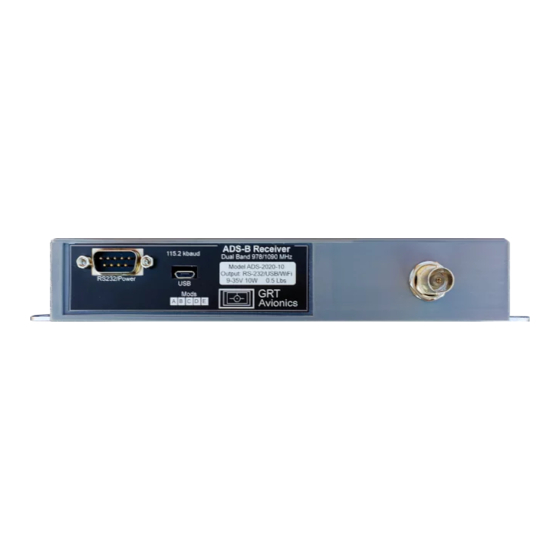
Summary of Contents for GRT Avionics ADS-B
- Page 1 ADS-B Discovery Dual Band Receiver Installation and User Manual Revision A April 2021 GRT Avionics, Inc. 3133 Madison Avenue SE Wyoming, MI 49548 616-245-7700 support@grtavionics.com www.grtavionics.com...
-
Page 2: Foreword
This manual describes the installation and operation of this receiver, using the software version shown in the Record of Revisions. Some differences may be observed when comparing the information in this manual to other software versions. GRT Avionics is not responsible for unintentional errors or omissions in the manual or their consequences. -
Page 3: Table Of Contents
Warnings, Cautions, and Notes....................1 Electronic Manuals and Internet Links..................1 Feedback and Corrections......................1 The Discovery ADS-B Receiver....................1 General Specifications........................2 Compatible Antennae........................2 INSTALLATION............................3 Choosing an Antenna Location....................3 Mounting the Antenna........................4 Choosing a Receiver Location....................4 Discovery ADS-B Receiver User Manual Rev. A... -
Page 4: Introduction
GRT Avionics, Inc. April 2021 Mounting the Receiver........................4 Antenna Wiring..........................5 Receiver Wiring to a GRT Avionics EFIS..................5 3.6.1 RS-232 Wiring..........................6 3.6.2 USB Wiring..........................7 Required GRT EFIS Settings for connecting via RS-232...........8 Required GRT EFIS Settings for connecting via USB............8 Other Applicable EFIS Settings....................8... -
Page 5: Feedback And Corrections
Interfaces: -RS-232 -USB -Wi-Fi 2.6 Compatible Antennas For maximum sensitivity, an external antenna is recommended. Although an antenna is included with the receiver, any external antenna designed for ADS-B may be used. Discovery ADS-B Receiver User Manual Rev. A... -
Page 6: Installation
Typically, the transponder and its antenna are located near the front of the airplane (to minimize the cable length between the two). In order to achieve the 3’ spacing required, it is common to locate the ADS-B receiver antenna aft of the transponder antenna, on Discovery ADS-B Receiver User Manual... -
Page 7: Mounting The Antenna
Further guidance is provided by AC43.12-2A, Chapter 3. 3.3 Choosing a Receiver Location The main considerations for the location of the ADS-B receiver are as follows: The aluminum base plate of the receiver is used to passively cool the receiver. -
Page 8: Antenna Wiring
RG-58 or RG-400 coaxial cable (50 Ω characteristic impedance) are acceptable wiring choices. RG-400 is recommended for cable lengths greater than 6’ (2m). 3.6 Receiver Wiring to a GRT Avionics EFIS The receiver may be connected to a GRT EFIS via RS-232 or USB connections. An RS-232 connection is preferred, as the d-sub connector is a proven technology in airplane applications and includes hardware to keep the connector in place. -
Page 9: Rs-232 Wiring
“Serial Out” connection from the EFIS display unit to the receiver is optional, it provides the receiver with AHRS and GPS data that it can then output to tablet/phone apps via Wi-Fi. This connection also allows for updates to the receiver’s software. The receiver provides Discovery ADS-B Receiver User Manual Rev. A... -
Page 10: Usb Wiring
The following diagram illustrates the wiring to a GRT EFIS using the USB port. The USB port provides the receiver with AHRS and GPS data that it can then output to tablet/phone apps via Wi-Fi. This connection also allows for updates to the receiver’s software. Discovery ADS-B Receiver User Manual Rev. A... -
Page 11: Required Grt Efis Settings For Connecting Via Rs-232
“GRT Discovery ADS-B In,” at 115,200 baud. 3.8 Required GRT EFIS Settings for connecting via USB On the Set Menu > General Setup page, configure the USB ADS-B to ON. 3.9 Other Applicable EFIS Settings If a USB GPS is connected to the USB Type A port (on the side next to the mounting holes) and is going to be used as a GPS source for the EFIS, configure it as GPS1 or GPS2 on the Set Menu >... -
Page 12: Dimensional Drawing
GRT Avionics, Inc. April 2021 3.10 Dimensional Drawing Discovery ADS-B Receiver User Manual Rev. A...


Need help?
Do you have a question about the ADS-B and is the answer not in the manual?
Questions and answers